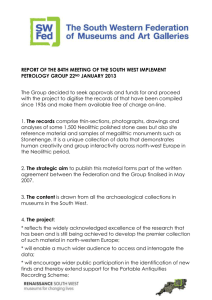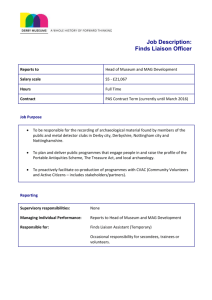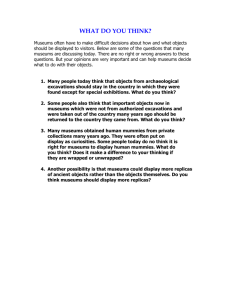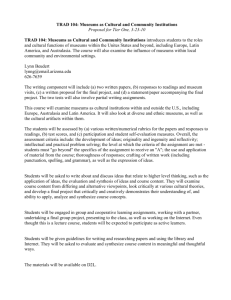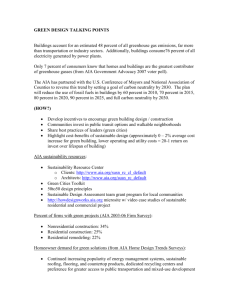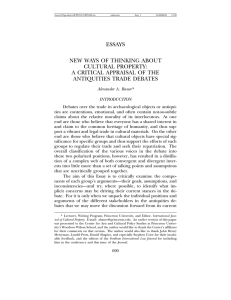AIA Cultural Heritage FAQ - Archaeological Institute of America
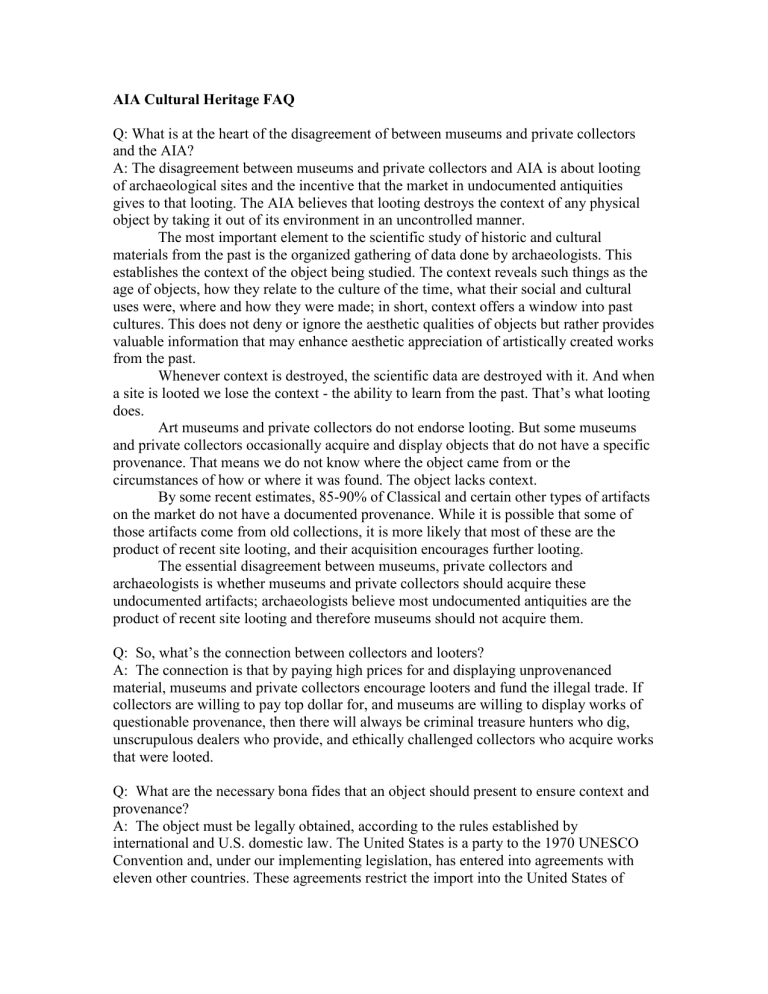
AIA Cultural Heritage FAQ
Q: What is at the heart of the disagreement of between museums and private collectors and the AIA?
A: The disagreement between museums and private collectors and AIA is about looting of archaeological sites and the incentive that the market in undocumented antiquities gives to that looting. The AIA believes that looting destroys the context of any physical object by taking it out of its environment in an uncontrolled manner.
The most important element to the scientific study of historic and cultural materials from the past is the organized gathering of data done by archaeologists. This establishes the context of the object being studied. The context reveals such things as the age of objects, how they relate to the culture of the time, what their social and cultural uses were, where and how they were made; in short, context offers a window into past cultures. This does not deny or ignore the aesthetic qualities of objects but rather provides valuable information that may enhance aesthetic appreciation of artistically created works from the past.
Whenever context is destroyed, the scientific data are destroyed with it. And when a site is looted we lose the context - the ability to learn from the past. That’s what looting does.
Art museums and private collectors do not endorse looting. But some museums and private collectors occasionally acquire and display objects that do not have a specific provenance. That means we do not know where the object came from or the circumstances of how or where it was found. The object lacks context.
By some recent estimates, 85-90% of Classical and certain other types of artifacts on the market do not have a documented provenance. While it is possible that some of those artifacts come from old collections, it is more likely that most of these are the product of recent site looting, and their acquisition encourages further looting.
The essential disagreement between museums, private collectors and archaeologists is whether museums and private collectors should acquire these undocumented artifacts; archaeologists believe most undocumented antiquities are the product of recent site looting and therefore museums should not acquire them.
Q: So, what’s the connection between collectors and looters?
A: The connection is that by paying high prices for and displaying unprovenanced material, museums and private collectors encourage looters and fund the illegal trade. If collectors are willing to pay top dollar for, and museums are willing to display works of questionable provenance, then there will always be criminal treasure hunters who dig, unscrupulous dealers who provide, and ethically challenged collectors who acquire works that were looted.
Q: What are the necessary bona fides that an object should present to ensure context and provenance?
A: The object must be legally obtained, according to the rules established by international and U.S. domestic law. The United States is a party to the 1970 UNESCO
Convention and, under our implementing legislation, has entered into agreements with eleven other countries. These agreements restrict the import into the United States of
artifacts that did not leave their country of origin before the date of the import restrictions or are not accompanied by an export license from their country of origin. (For more information, see the State Department website: exchanges.state.gov/culprop.)
In addition, many countries that are rich in archaeological resources have enacted national ownership laws. This means that any antiquity in the ground at the time the ownership law was enacted is the property of the nation. If such an artifact is dug up and removed from the country without permission it is stolen property, and remains so even after it is brought to the United States. Those objects should be dealt with in the same way as one would treat any other stolen property.
The third legal consideration is that the artifact must be properly imported into the
United States. This means that its correct value and country of origin must be declared to
U.S. Customs.
Museums should also take into consideration ethical concerns to discourage the looting of sites. This means that even if it cannot be proved that an object was illegally acquired, the museum should not acquire it if it does not have a documented history back to a specific date (such as 1970) to assure that the acquisition is not contributing to the contemporary looting of sites.
Q: Does the AIA want to abolish art museums?
A: No, we support the display of artistic and cultural objects for the benefit of all, though the public should be aware of how the objects got there – were they legal acquisitions?
And American museums are learning that. Look at the recent repatriation of works by the
Museum of Fine Arts in Boston, the Metropolitan Museum of Art in New York City, and the Getty Museum in Los Angeles. Furthermore, some museums are changing their acquisitions policies and making them more open to public scrutiny to try to ensure that their future acquisitions adhere to stricter ethical and legal standards. The Getty Museum recently set an example by accepting the 1970 date of the UNESCO Convention as the cut off date for acquiring unprovenanced antiquities and made their new policy available on their website.
Q: Isn’t it better for an object to be acquired by a museum with curators, conservators, air conditioning, security, and an engaged public than to languish in much less favorable conditions in the country of origin?
A: Of course, the greater the resources available to display and conserve a work of art, the better it is for the work. But in most instances, it’s the choice of the country of origin about what to do with an object. Also, at this point, many countries of origin have state of the art museums. There is no reason to assume that an object will be better cared for in the U.S. than in many other countries.
Q: Doesn’t the world deserve to see these objects? Aren’t they part of the cultural heritage of all of us, not just of those who live in the area where the object was found?
A: Archaeological objects are part of the world’s culture and we should do everything possible to make them available and safe. But it is up to the owners to decide what to do with them. Additionally, one enticement for the repatriation of objects is the chance for valuable and culturally significant long-term loans, bringing new and exciting objects from countries of origin to new audiences. The Museum of Fine Arts, Boston, The
Metropolitan Museum in New York and the Getty Museum have all negotiated favorable long term loans in return for the repatriation of objects to their counties of origin. This establishes good relations between the museums who engage in these practices, the countries of origin and ultimately the United States. These arrangements also bring new and changing material before the public for their interest and enjoyment and allow scholars and students the opportunity for scholarly research, excavation, and publication.
Everybody wins!
Q: With local stewardship can come serious risk. Does the AIA really think that the
Taliban should have been in charge of the Buddhas at Bamiyan?
A: Of course the AIA does not endorse the destruction at Bamiyan, but archaeologists are as unable to prevent this destruction as anyone else, and predicting an event like this is not possible. That destruction was more analogous to a fire in a museum- tragic but probably not preventable.
Q: Isn’t this disagreement between collectors and archaeologists really the work of a bunch of radical archaeologists who have lost touch with the public?
A: No, in fact, the stand taken by the AIA, the oldest and largest archaeological organization in North America, is representative of the point of view of all the mainstream archaeological organizations in the U.S. including the Society for American
Archaeology, the Society for Historic Archaeology, the American Schools of Oriental
Research and others. It’s also the stance of other major international archaeological groups. In fact, in January, an unprecedented agreement will be signed among the AIA, the German Archaeological Institute and the Institute of Archaeology of the Russian
Academy of Sciences to battle the scourge of looting. A Harris interactive survey published in 2000 also showed that public opinion agrees with the position of the AIA— the main value of archaeological sites is scientific and educational and U.S. museums should not acquire illegally exported artifacts.
Q: What about the orphaned object that is out of the ground and circulating in the market with its context already destroyed and it provenance uncertain? Shouldn’t this object be acquired and given a good home?
A: The acquisition of these objects encourages looting. Objects like this are likely stolen.
When confronted with an object like this, the best thing to do is to contact the authorities.
You would not buy a hot car or a diamond watch from a disreputable source -- why buy an antiquity from a disreputable salesperson?
Q: In many cases there are multiple copies of certain antiquities, some with so many duplicates that they cannot all be displayed. What is wrong with the trade in multiples?
A: Some countries do allow trade in duplicates, including Israel. But it is difficult to identify a duplicate from a country that allows trade, and it’s difficult to prevent the sale of new objects as duplicates. Furthermore, most museums and private collectors are interested in high-end, unique objects, not “duplicates.” It’s primarily the trade in expensive, unique artifacts that drives the illegal market.
Q: Why is the AIA trying to prevent scholarship by refusing to publish information about unprovenanced material? Isn’t that censorship?
A: The AIA and its journal, the American Journal of Archaeology (AJA), do not forbid publication. Our current policy on the publication of recently acquired antiquities states that “the
AJA will not serve for the announcement or initial scholarly presentation of any object in a public or private collection acquired after December 30, 1973, unless its existence is documented before that date, or it was legally exported from its country of origin. An exception may be made if, in the view of the Editor, the aim of publication is to emphasize the loss of archaeological context.” We believe that publishing undocumented archaeological objects for the first time in the AJA enhances their commercial value and hence encourages looting and trade in undocumented antiquities.
However, we do allow initial publication of such objects if the aim is to make known the fact that the objects may have been looted and to demonstrate what is lost if the object is without provenance. This will, in effect, highlight the threat to the archaeological record that the illicit trade in antiquities creates and keep the checkered past of an object out in the open and part of the scholarly debate. The AIA’s Code of Ethics specifically urges members to refrain from activities that enhance the commercial value of undocumented antiquities.
Q: Should all antiquities be repatriated?
A: No, not if they are legally obtained and well-provenanced and documented.
Q: The AIA supported China’s claim to control the overseas market in its looted antiquities. Won’t this devastate the Chinese overseas art market, affecting dealers and museums here in this country?
A: The AIA supported China’s request to limit the trade in undocumented Chinese antiquities. The main reason is to discourage the vast looting underway in China. Chinese archaeologists report that one-third of China’s approximately 400,000 sites have been looted. That is deplorable and the AIA wants it stopped. The AIA opposes the trade in looted artifacts; it does not oppose the legal trade in other forms of art, including fine art, from China.

